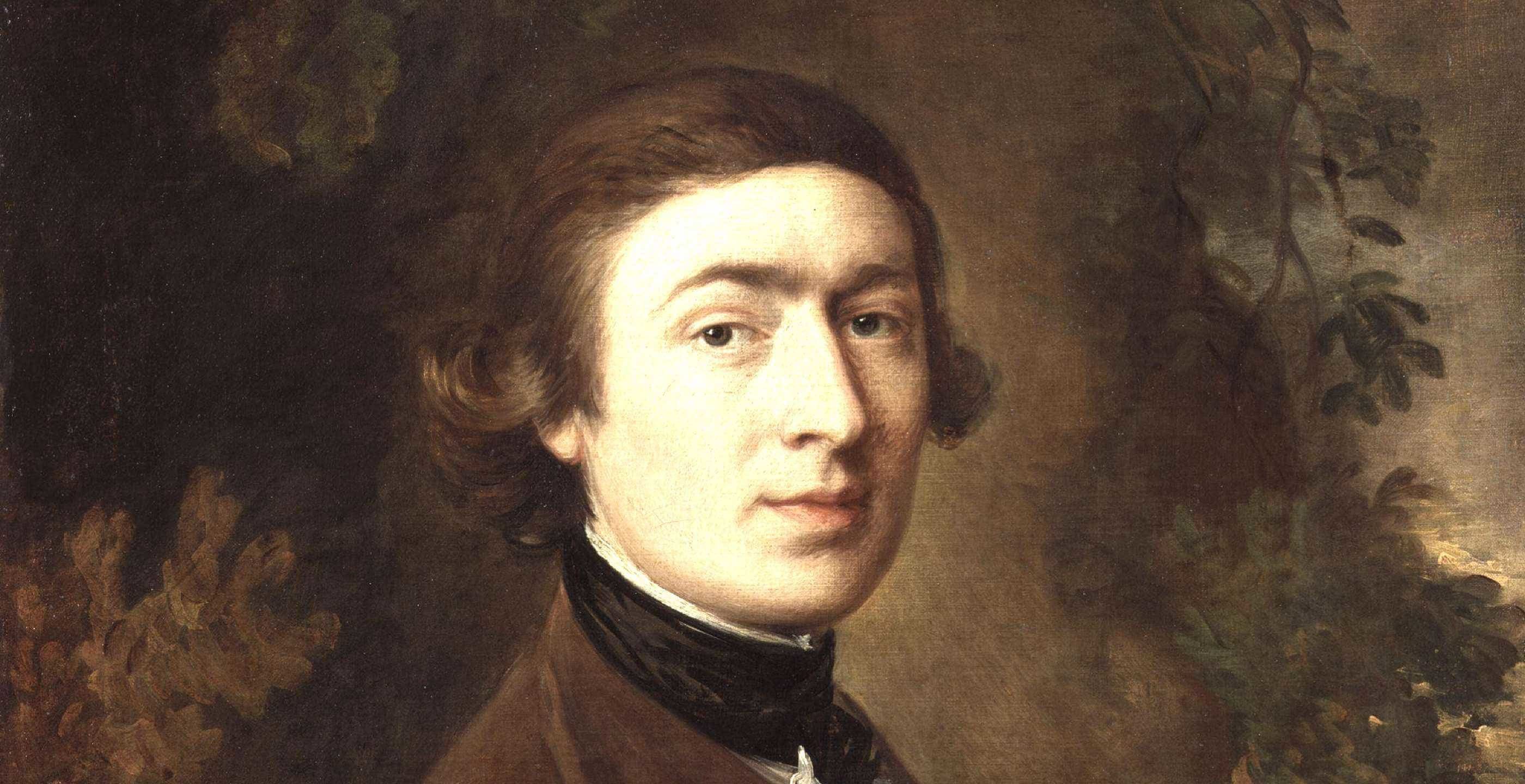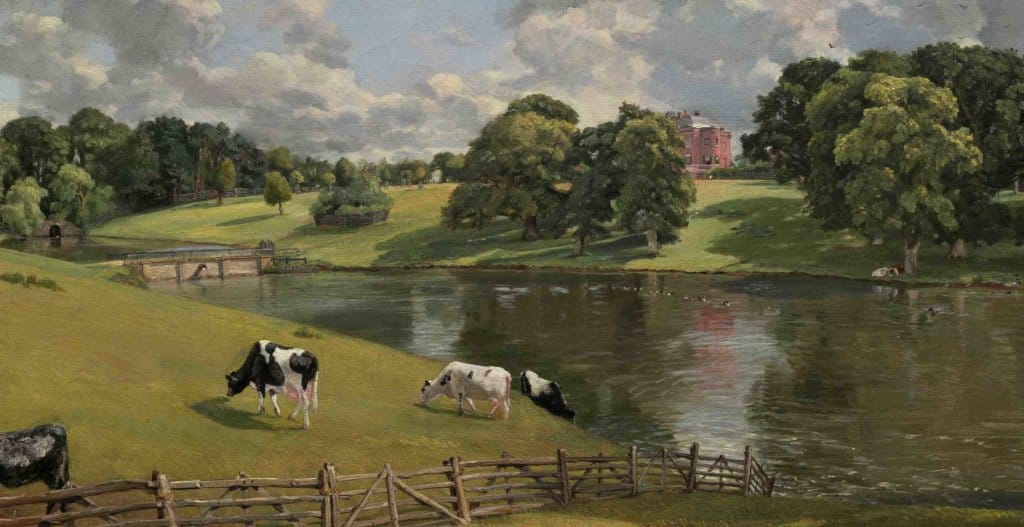On 2nd August 1788, Thomas Gainsborough passed away. Widely regarded as one of the best portrait artists of the 18th century and a founder of the British landscape school of his century, his artistic legacy endures to this day.
Born in 1727 in the small market town of Sudbury in Suffolk, he was the youngest of John and Mary Gainsborough’s nine children. As a young boy, his artistic aptitude was evident in his early sketches and paintings of the surrounding countryside in his local area. He embraced landscape painting, inspired by the woodland and fields surrounding Sudbury. This early motivation was vital as his passion for landscape painting would feature throughout his career.
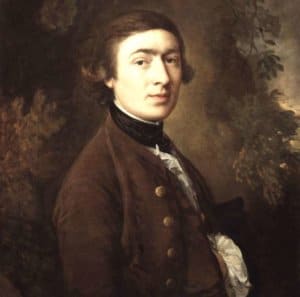
His propensity for artistic endeavours at such a young age impressed his father, who marvelled at his drawing and painting skills which included a self-portrait completed by the age of ten. Keen not to have his talent wasted, Gainsborough’s parents allowed him to leave home and by the age of thirteen he had left his rural surroundings to embrace the big city and work in London under the tutelage of the French painter, Hubert-François Gravelot.
Whilst studying in London, he immersed himself in the artistic community in the area of St Martin’s Lane Academy. Amongst the figures that would prove instrumental in nurturing his talent was the famous William Hogarth, a painter, engraver, printmaker and cartoonist. In addition, the English painter Francis Hayman, who would become one of the founding members of the Royal Academy, allowed Gainsborough to assist him in the decoration of the Vauxhall Gardens and became a strong artistic influence for young Gainsborough.
Whilst his talent was flourishing, by the age of seventeen he had already established his own studio in the capital and a year later married Margaret Burr, the illegitimate daughter of the Duke of Beaufort. Meanwhile, Gainsborough’s work was predominantly landscapes which had been his original inspiration since he was a small boy, but he was failing to receive enough financial remuneration for his efforts. In 1748 he subsequently returned to Sudbury and concentrated on portraiture. A few years later he moved his family, which now included two daughters, to Ipswich where he continued to work as a portrait artist with mixed results. His commissions had increased but the clients consisted of squires and merchants and he was forced to borrow money.
After struggling to make a living as a portrait artist he finally got the break he needed when he and his family moved to Bath, where they settled at No 17, The Circus. Whilst established there, he took time to study the works of Van Dyck and in time was able to attract some impressive clientele and establish himself as a well-known, respected artist. Whilst his talent was being recognised in important social circles, he decided to send his work to what is now known as the Royal Society of Arts and by 1769 he was regularly submitting pieces for the annual exhibition at the Academy. In order to gain more kudos and draw further attention to his work, he purposefully selected portraits of the most well-known clients. This was a clever move by Gainsborough, as it drew interest and appeal and he became part of the artistic set with nationwide interest in his work. So much so, that he became one of the founding members of the Royal Academy.
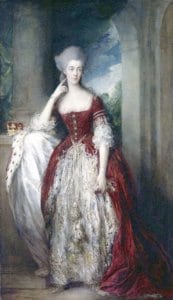 Portrait of Anne, Duchess of Cumberland by Thomas Gainsborough
Portrait of Anne, Duchess of Cumberland by Thomas Gainsborough
Now established as a famous and popular portrait artist he moved back to London, settling in Schomberg House, located on Pall Mall. Today it is recognisable by the commemorative blue plaque outside. Whilst in London, he continued to exhibit his work at the Royal Academy with portraits of high profile members of society such as the Duke and Duchess of Cumberland. He was able to continue presenting his work for the next six years, although he expressed his desire to work on his preferred style which was landscapes. Voicing his concerns to his friend William Jackson, he maintained that he much preferred landscapes and wished he could leave portraiture and his busy London life behind.
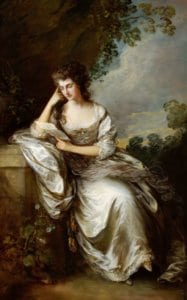 Portrait of Frances Browne, Mrs John Douglas, at Waddesdon Manor. Licensed under the Creative Commons Attribution-Share Alike 4.0 International license.
Portrait of Frances Browne, Mrs John Douglas, at Waddesdon Manor. Licensed under the Creative Commons Attribution-Share Alike 4.0 International license.
During the 1780s Gainsborough’s style was evolving. In an attempt to embrace his preference for landscapes, he began to incorporate a backdrop of a landscape in his portraits, for example his portrait of Frances Browne, Mrs John Douglas, which can now be viewed at Waddesdon Manor, Buckinghamshire. Whilst the sitter of this particular portrait was not particularly well-known, Gainsborough sought to include it in his private exhibition in 1784. In this portrait he was able to use a characteristically light palette to incorporate the sitter into her environment with the clouds and billowing light pastel fabric creating a sense of continuity and fluidity between the subject and her surroundings.
Gainsborough would continue to create this style of portrait, which proved popular amongst his esteemed and high ranking clientele such as Anne, the Countess of Chesterfield, whose portrait was completed in 1778 and conveyed the countess set against a rural backdrop with foliage and an illuminated sky.
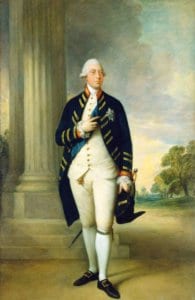 Portrait of King George III by Gainsborough, 1781
Portrait of King George III by Gainsborough, 1781
After completing portraits of King George III, Gainsborough received many more royal commissions. This understandably increased his standing in artistic circles and gave him more influence in which to make decisions at the Academy on how his work was to be exhibited. However, despite his increased prestige and reputation as one of the best portrait artists in England, Gainsborough was not without his rivals, most notably the Academy president and by 1784 the new royal painter, Joshua Reynolds. He was, along with Gainsborough, one of the leading portrait artists in the late eighteenth century, although with differing styles of artistic execution: Reynolds was more inclined to include Renaissance references in his work.
In his later years Gainsborough embraced his preferred subject matter, landscapes. He painted a series of landscapes on glass using oils which could be viewed with an instrument called a “Showbox”, which is now on display at the Victoria and Albert Museum. The machine works by using a magnifying lens and a number of glass panels which are lighted. Along with a fellow artist, Richard Wilson, he became known as one of the founding fathers of the 18th century British landscape school.
In the summer of 1788, Gainsborough passed away, with his last words said to be “Van Dyck”. He had an illustrious career with many fine portraits and landscapes showing his artistic talent and power in composition. In a eulogy given by his former rival Sir Joshua Reynolds, with whom he had reconciled before his death, remarked that he was able to produce “a high degree of excellence” in whatever project he put his mind to. Gainsborough is still remembered today as one of the best artists of the eighteenth century, accomplished in portraiture and landscape. His legacy hangs on the walls of many museums and galleries for us all to enjoy.
Jessica Brain is a freelance writer specialising in history. Based in Kent and a lover of all things historical.
